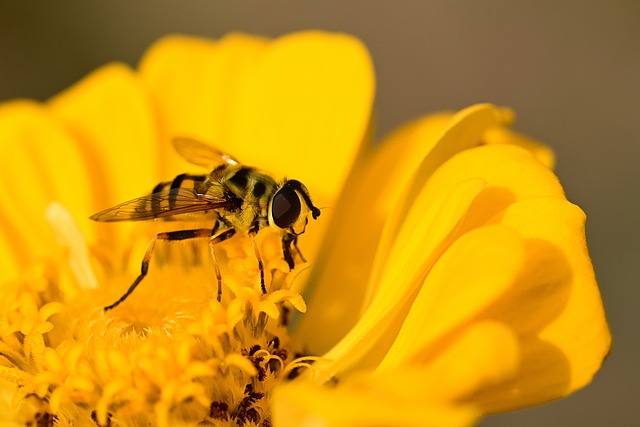Yellow jackets, aggressive pests with complex social structures, require strategic removal. Traditional chemical methods raise environmental concerns, driving a shift towards eco-friendly solutions. Professional services offer safer alternatives like natural repellents and heat treatments, minimizing ecological impact while effectively eliminating colonies. Proactive prevention involves sealing entry points, regular inspections, and food source management, reducing re-infestation risks and simplifying future removal efforts. Opting for professional yellow jacket removal supports conservation and ensures humane, environmentally conscious pest control practices.
In many regions, yellow jackets are a common nuisance, but their removal poses environmental challenges. This article explores eco-friendly solutions for safely eliminating these stinging insects while preserving biodiversity. We delve into the behavior and habitat of yellow jackets, comparing traditional methods with environmentally conscious alternatives. Additionally, expert techniques for professional yellow jacket removal and preventive measures to avoid future infestations are discussed, offering a holistic approach to coexisting with nature.
Understanding Yellow Jackets: Behavior and Habitat
Yellow jackets, scientifically known as Vespidae, are a common pest during the warmer months. These insects are highly social and live in colonies with a queen, workers, and males. They’re known for their aggressive behavior when protecting their nests, which can be located in various habitats, including trees, shrubs, and even beneath structures like decks or patios. Understanding their behavior is crucial when considering professional yellow jacket removal, as it helps experts determine the best strategies to safely evacuate colonies without causing harm to humans or the environment.
While some people may view them as simply a nuisance, professional yellow jacket removal services play a vital role in maintaining a harmonious balance. They employ safe and eco-friendly solutions that consider the complex life cycles of these insects, ensuring that colonies are eliminated humanely while minimizing the impact on local ecosystems.
Traditional vs Eco-Friendly Removal Methods
In the realm of pest control, traditional methods often involve hazardous chemicals and toxic substances, raising environmental concerns. When it comes to dealing with yellow jackets, a common insect that can pose a threat to humans, there’s a growing emphasis on eco-friendly solutions. Traditional removal techniques may use powerful insecticides, which can have detrimental effects on non-target organisms, including beneficial insects and local ecosystems.
Eco-friendly practices promote safer alternatives for both humans and the environment. Professional yellow jacket removal services now offer methods that minimize ecological impact. These include using natural repellents, trapping systems, and heat treatments, ensuring effective control without resorting to harmful chemicals. Such approaches not only protect nearby plants and animals but also contribute to a healthier and more sustainable environment, making them ideal choices for those seeking professional pest management.
Professional Safe Removal Techniques
When it comes to dealing with yellow jackets, professional safe removal techniques are essential for both your safety and the well-being of these often misunderstood insects. Many companies specialize in eco-friendly pest control, employing trained experts who can identify and remove nests while minimizing environmental impact. These professionals bring specialized equipment, including protective gear and safe disassembly tools, to ensure the job is done efficiently and without harm to nearby flora and fauna.
Unlike do-it-yourself methods that may involve toxic chemicals or risky direct contact, professional yellow jacket removal focuses on non-lethal strategies. This includes using one-way escape cages, which allow the insects to leave but not re-enter, and employing natural repellents. By opting for expert intervention, you contribute to conservation efforts while enjoying peace of mind, knowing that these skilled practitioners handle the situation with care and expertise.
Preventive Measures for Future Infestations
To prevent future infestations, it’s crucial to take proactive measures after a yellow jacket removal process. Professional yellow jacket removal experts recommend sealing all potential entry points into your home or building. This includes checking and securing windows, doors, vents, and any cracks in walls or foundations. Regularly inspecting and maintaining these areas can significantly reduce the likelihood of re-infestation.
Additionally, eliminating potential food sources nearby is essential. Professional yellow jacket removal services suggest keeping garbage bins tightly sealed, cleaning outdoor dining areas promptly after meals, and storing fruits and vegetables in refrigerated containers. By minimizing accessible food, you deter yellow jackets from establishing nests in close proximity to human habitats, making future removal efforts easier and less frequent.
When it comes to dealing with yellow jackets, opting for eco-friendly solutions offers a safer and more sustainable approach. By understanding their behavior and habitat, we can employ traditional yet effective methods that minimize harm. For instance, using natural repellents and setting traps strategically can be highly successful. If professional help is required, modern techniques ensure safe removal without pesticide use. Additionally, taking preventive measures like sealing entry points and maintaining cleanliness significantly reduces the risk of future infestations. Remember, prioritizing eco-friendly practices not only benefits the environment but also keeps your space secure and pest-free in the long run, making it a win-win for everyone. For any concerns regarding professional yellow jacket removal, consult experts who specialize in these modern, safe techniques.
